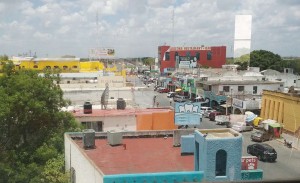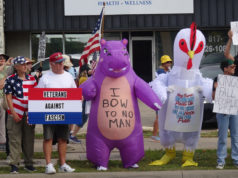Brownsville was about 40 miles from where we would enter Mexico, but Chepa wanted the girls to be able to step out into the Gulf at Padre Island, so that’s where we headed. Unfortunately, it was starting to get dark before we arrived, so we simply took a room at the Magnuson Hotel for the night. We went out to eat and then headed back to the hotel, where Sierra and Alexa got in a couple of hours at the hotel swimming pool. Road trip, right? Somebody’s got to have fun.
There was a reassuring sign the following morning as we drove to the international bridge at Nuevo Progreso: A convoy of pickup trucks, each hauling one newish but damaged car, was headed toward Brownsville. It was an older practice that I hadn’t heard much of in several years: Mexican drivers would buy wrecks at auctions on the U.S. side, bring them into the Mexican border towns, have them repaired, and then sell them to buyers who would come from all over Mexico. Drug war violence had largely stopped the trade. People were too frightened to make their way to the border with thousands in cash on their persons. That a convoy of perhaps 30 pickups was headed to Brownsville and then on to Matamoros, was, as I said, reassuring.
There is no town to speak of on the U.S. side of the international bridge, just a couple of large buildings and a parking lot. Though it was still early, not yet 8 a.m., several dozen cars were already sitting in the lot. Another good sign: We wouldn’t be the only ones crossing into Mexico that day.
We paid $2 to park and 50 cents to walk through the turnstyles at the U.S. foot of the bridge, and then we stopped to talk to a couple of ICE officers about the situation on the other side.
“Not a problem, sir,” one of the officers said, “so long as you’re not planning on doing anything illegal.”
“He’s joking,” said a female ICE agent. “Y’all wouldn’t be doing anything like that. It’s fine over there. Going to the dentist?”
We told them we were.
“I need to get over there soon,” she said. “I got a tooth that’s starting to bother me a lot. Have a good time, and don’t stay too late.”
We started over the bridge, a covered walkway that crosses the storied Rio Grande, the laziest river to ever be called “Grand.” We stopped for photos at the international boundary sign and then made our way down the bridge’s slope into Mexico. While the U.S. side of the bridge is desolate, the Nuevo Progresso part sort of jumps out at you. In bright colors, lots of blues and pinks, billboards shout, “Dental Work!,” “Welcome, Texas Visitors!,” and “Easy, Inexpensive Cosmetic Surgery!”
Vendors at tables set up on the crowded sidewalks of the main street sold clothes, hats, knock-off sunglasses and purses, Mexican blankets, and six-foot ceramic statues of the Virgin Mary with eyes that would follow you across the room for the rest of your life. Touts were everywhere, asking if we needed dental work, surgery, Viagra or other medications, or would we just like a day spa?

Chepa thanked them and pushed through the bustling crowd to the dentist she had visited before, one of at least 40 in this section of the street.
No appointments necessary.
“Wait here,” she said. “I’ll make sure the same dentist is still running this place.”
I sat on a bench outside the storefront operation: The girls had gone inside and were sitting on a comfortable couch while their mom spoke to someone at the front desk. While I waited, I was surprised at how many elderly couples and whole families I saw, some looking as if they had come from Connecticut. Two tall men in cowboy hats strolled by and nodded a Texan hello to me before one turned to the other and said, “Do you realize we just saved $2,000 on those prescription drugs? That’s Mexico for you.”
“That’s goddamn big pharma in the U.S.A. for you, you mean!” answered the other before their voices melded into the general din.
In a few moments, Chepa called me in. A young man sitting behind a computer at the front desk of the well-appointed waiting room stuck out his hand to shake mine and then introduced himself. As he did, Chepa was ushered behind a partition to a modern dental chair.
“Keep an eye on Sierra and Alexa,” she said.
The fellow looked at me. “So what work do you need done today?” he asked.
I told him about my old accident and said I needed a cleaning, a bridge, and a loose tooth removed.
“Good,” he said. “Why don’t you come with me?”
I turned to the girls on the couch.
A young woman who was also at the front desk said she would keep an eye on them, though I would be able to see them at all times.
I took a seat, uncomfortably lay down, and took a shot of Novocaine. The open cubicle was spotless. The tools and needle came from sealed packages. It was just like the States but less formal: I could see Chepa getting worked on in the next open cubicle, and if I turned to the left I could see the girls on the couch. They were making funny faces at their mom and me.
Ten minutes later, the loose tooth was gone, along with a cracked capped tooth. Another 20 minutes more, and a mold of my mouth and missing teeth had been made. Toss in the cleaning, and the whole operation took probably 45 minutes. Painless, effortless.
“OK,” I was told. “That’s it.”
“Well, how many days before I come back to see if the denture — I never had a denture before, and I am not looking forward to it — is ready?” I asked.
“Come back at 4 today. It will be finished, and you can go home. And no one will know it’s a denture.”
I had never heard of anything nearly as fast. I’d had some work done in both Peru and the States, and nothing was done in a matter of hours. The dentist reassured me that not only were his people good, they were fast.
As I stepped out of the chair and called in Alexa for her root canal, I was surprised to see the dentist hand my mouth mold, in a baggie, to a young man who stuffed it into a cloth bag hanging around his neck. He then took off down the street in the direction of the U.S.A.
“Was that my mouth mold that guy just took off with?” I asked.
I was told it was.
“Where’s he going with it?”
“Across the bridge to the tooth factory on the U.S side. All of the outside work is done there. That allows us to take insurance and gives us a great product.”
It was too late to sell me on his service, but that was what he sounded like he was doing.
A few minutes later, and another runner took Chepa’s mold and raced off with that. I wasn’t sure the guy was telling the truth about teeth factories on the U.S. side of the border, but I later checked and discovered he was at least telling the truth about U.S. insurance companies, who pay a lot of Mexican border town dentists. With the high deductibles and annual limits for dental work that most insurance plans pay, reducing those costs by more than half certainly drives a lot of clients to cross the border to seek treatment, particularly if it’s extensive.
There are several reasons for the low cost of treatment in Mexico: Dentists there don’t have a lot of debt after finishing dental school, often as low as $20,000 for the entire five-year program. U.S. programs often cost $150,000 or more.
Mexican dentists, according to a July 2010 CNNMoney report, also earn considerably less than their counterparts north of the Rio Grande, about two-thirds less annually, even for specialists. That means fewer costs passed onto patients.
Add to that no regulation forcing Mexican dentists to carry malpractice insurance and that most of the border business is done in cash, reducing the cost of chasing payments, plus less expensive office rental costs, and it all adds up to less expensive work that is particularly attractive to the uninsured and underinsured.
Dentists on the U.S. side have often encouraged their lawmakers to force U.S. insurance companies to stop making payments south of the border, but the insurance companies themselves fight those efforts because of how much less they need to pay out in claims from Mexico.
******











